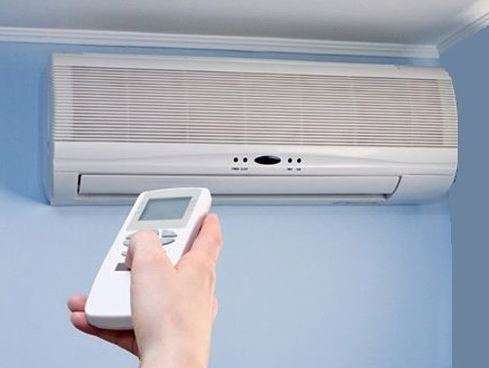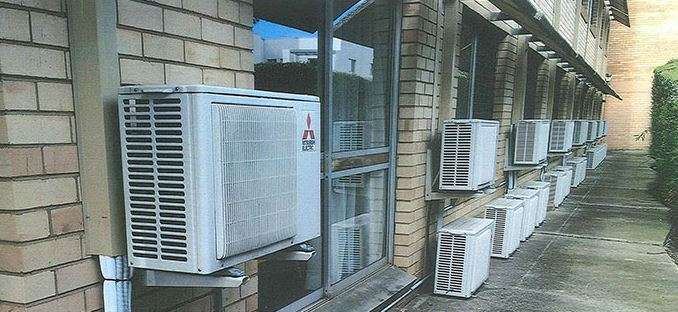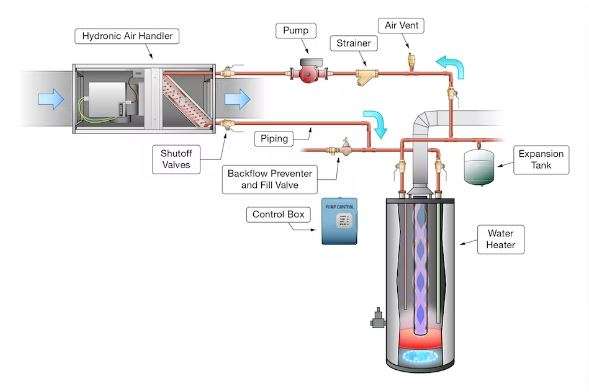Cooling and Heating
In this article, we will discuss Cooling and Heating. Understanding how Cooling & heating is carried from the outside into your home and from your home to your body is critical to comprehending the issue of keeping your house cool. Understanding the processes that keep your body cool is essential for understanding home cooling & heating strategies.
Heat is carried to and from objects like you and your house via three processes: conduction, radiation, and convection.
Conduction is the movement of heat through a solid material. Heat is transmitted into your home through the roof, walls, and windows on hot days. Roofs that reflect heat, insulation, and energy-efficient windows will all help to prevent heat conduction.
Table of Contents
In this article, we will discuss Cooling and Heating.
Key Points
- The finest heating and cooling system is one that is appropriate for your environment, home size, and lifestyle.
- Having the proper system size for your home will save you both energy and money. Buying a system that is too big or too tiny means you will waste energy and end up paying more in the long run.
- You can pick between a central heating or cooling system, which heats or cools most or all of your home’s rooms, and a space heating or cooling appliance, which heats or cools a single area or room.
- Combination heating and cooling systems can be used to heat in the winter and cool in the summer. Reverse cycle air conditioners, hydronic systems, and ground-source heat pumps are examples.
- Heat pumps (which also include reverse cycle air conditioners) are the most energy-efficient combined heating and cooling system available.
- Ducted air and in-slab floor heating are two central heating alternatives. Electric, gas, and wood space heaters are all options.
- Air conditioners or evaporative coolers are central cooling solutions; fans or portable air conditioners and evaporative coolers are space cooling options.
- Correctly set your thermostat. Each degree of extra heating or cooling in the winter or summer increases energy consumption by 5 to 10%. Set the thermostat to 18°C in the winter and 25°C in the summer.
Recognizing heating and cooling
Heating and cooling utilise the most energy in the average Australian home, accounting for over 40% of total household energy use. As a result, whether it comes to keeping your home suitably warm or cold, it is critical to prioritise your investment.
If you are building a house, using passive design principles to reduce your heating and cooling needs is the greatest long-term alternative. This should be supplemented by wise household behaviour. There are numerous free and low-cost solutions available to help you get the most out of your heating and cooling equipment. It is also critical to select the proper system for your needs in order to maximise your comfort while minimising your expense and environmental impact.
Climate
Your climate will be your first consideration when choosing heating and cooling selections for your property. Do you require more heating, more cooling, or a combination of the two?
Consider making adjustments to your home to increase its thermal performance. Improving the thermal performance of your home may indicate that you may not require as much heating or cooling as you believe.
Sizing
One of the most crucial buying suggestions for a heating or cooling appliance is to get the right size. If you get one that is too large for your needs, you will spend more money and waste energy and money operating it. If you buy one that is too tiny, the appliance will have to work ‘harder,’ consuming more energy to maintain the correct temperature.
Consider the area of your home that you want heated or cooled; how frequently and for how long do you require heating or cooling? For example, if temperatures in your climate zone drop substantially at night, you may just need to cool a small living area during the summer heat, then expose the bedrooms to cool breezes at night.
In this article, we will discuss Cooling and Heating.
Space Versus central
Central heating and cooling systems are intended to heat or cool the entire home (for example, through ducted vents in most or all the rooms). Space heating and cooling systems are designed to heat a small area or one room and have a single source of heating or cooling.
The decision between central heating and cooling systems and equipment that heat or cool individual rooms or spaces is an important one for your home. When rooms are left unoccupied or a house is substantially empty, central systems frequently squander energy by conditioning empty spaces. Using a space heating or cooling unit just in rooms where it is needed is the greatest option for an energy-efficient home.
Some central systems feature zone settings that allow heating and cooling to be turned on or off in different areas of the house that are used less frequently, making them more efficient.
A third option is to employ a combination of systems. For example, you may want to have a central system that heats and cools your home’s major living rooms, but then use electric space heaters in a bedroom or study for brief periods of time.
In this article, we will discuss Cooling and Heating.
Heating and cooling options
Some systems incorporate heating and cooling options, which can be switched depending on the season. Others merely provide heating or cooling. Your choice will be influenced by your climate as well as the thermal performance of your home.
Options for combined heating and cooling
Reverse cycle air conditioners
A reverse cycle air conditioner uses electricity to heat and cool your home in the winter and summer. A heat pump is a type of air conditioner (refer to Heat pumps below). The mechanism gathers heat from the outside air and distributes it throughout the space when in heating mode. It gathers heat from inside air and discharges it outdoors when in cooling mode. If you are considering purchasing an air conditioning system, it will have an energy rating label that indicates how efficient the appliance is in comparison to other models of the same size. The zonal energy rating label provides an efficiency rating for each season for three Australian temperature zones, allowing you to understand how the appliance will perform in your home.
In this article, we will discuss Cooling and Heating.


Reverse cycle air conditioners, regardless of fuel source, provide convective heat and are the most energy-efficient heater and cooler available. Even units with lesser efficiency ratings (for example, 2 to 3 energy stars) are much less expensive to operate and emit fewer greenhouse gases than other heating and cooling appliances.
In this article, we will discuss Cooling and Heating.
Hydronic systems
Hydronic systems circulate hot or cold water or another fluid through radiator panels installed in rooms or beneath the floor (refer to In-slab heating below).
The fluid can be heated or cooled by electric or solar pumps, or by gas if just heating is required. As a backup, solar systems can employ gas, wood, or electric heating.

Hydronic systems are often more expensive to purchase and install than space heaters. Make sure your water circulation pipes are properly insulated, and utilise smart controls to manage pump usage. Higher operating expenses are typically caused by inefficient water circulation or inadequate pipe insulation. To avoid heat or cold loss to the outside, exterior walls behind panels must also be insulated. Install wall cavity insulation or a layer of fitted reflective foil beneath the radiator panel on the internal wall.
Heat pumps
Heat pumps are classified into three types: air-source, water-source, and ground-source. To heat the residence, each of these pumps employs a heat exchanger to extract heat from the air, water, or ground, as appropriate.
A reverse cycle air conditioner, also known as an air-source heat pump, pulls heat from the air to heat the home (refer to Reverse cycle air-conditioners below). These are some of Australia’s most frequent and effective heating methods. In general, Australia lacks adequate water resources to support the usage of water-source heat pumps. Ground-source heat pumps can function effectively under high heat or cold. However, they are still prohibitively expensive for most residential applications in Australia, and adoption is still limited.

Pipes are run deep into the ground for ground-source heat pumps, where the temperature is consistent all year. This means that such systems can be utilised for both cooling and heating in the summer and winter.
Air is pumped through the pipes, cooling or heating as it travels through the ground. The pipe system must be large enough to allow the air to change temperature as it flows through the pipe. The water is then pumped back into the house.
If the system is used solely to cool the air in a residence, additional precautions must be taken to avoid mould in the pipe, which can occur as a result of the cooling air causing moisture. Alternatively, ground-source heat pumps can be utilised in conjunction with air conditioning to precool the air and increase the efficiency of the air conditioner. To produce the same effect, air-conditioning refrigerant can be pumped via the pipe. The method can also be used to pre-heat water for hot water systems in the winter.
In this article, we will discuss Cooling and Heating.
Options for heating
Radiant and convection heating are the two basic types of heating. Radiant heaters primarily heat people and objects by direct heat radiation. Convective heaters use convection to warm and circulate the air in a room. Heating through conduction through direct touch with a person is also used in less prevalent forms of heating, such as heated flooring
Different types of heating are best suited to different situations:
- A mix of radiant and convection heating works best in larger rooms with high ceilings.
- Space convective heating is useful in small rooms.
- Radiant heating works well in bigger draughty rooms or bathrooms.
Convection is used in central heaters; radiation, convection, or a combination of the two is used in space heaters.
Ducted air heaters
Hot air is circulated through roof or flooring ducts in ducted systems, providing convective heat. These systems can run on gas or electricity, and they can also be used to cool (refer to Reverse cycle air-conditioners below).
Because warm air naturally rises and floor outlets distribute heat to where it is most required, floor outlets are generally preferable than ceiling outlets for heating. Ceiling outlets can also be used, especially when rooms are sealed against draughts from the outside. If cold air enters through outside-facing doors, it can build a layer above the floor, preventing less dense warm air from ceiling vents from heating the air near the floor, resulting in a “cold feet-warm head” dilemma.
As with any heater, make sure the system is appropriately suited for the home. Ducts should be the proper size, with adjustable outlets. If cooling is also employed, the ducts must be larger. Design the system so that the area heated may be managed, and add zoning to allow heating to be turned off in unoccupied sections. Accredited professionals should design and install ducted systems.
When utilised for heating, it is critical to have a return air channel from each outlet back to the central system. Without it, warm air escapes and the system draws in cold air, significantly limiting its efficacy. A return path is formed by a gap under the door between the room and the central return air intake in each room with a duct outlet fitted.
If you have an electric ducted air conditioner, it will have an energy rating label that shows you how efficient the appliance is in comparison to other models of the same size.
In this article, we will discuss Cooling and Heating.
Underfloor heating
Hot water pipes, electric wires, or mats are put either in a concrete slab or in the concrete topping of a slab to give heating to living spaces. They are installed during the construction or refurbishment of a building.
Radiant, convective, and conductive heat are all provided via in-slab systems. Because of the high thermal mass of the slab, they are slow to warm and cool and are thus unsuitable for residences where heating is required only periodically, for short periods of time, or in changing weather. On cloudy or exceptionally cold days, they are ideal as a backup for passive solar heating of thermal mass. When you heat the slab, it loses its ability to store heat from passive solar gain.
Electric in-slab heating often consumes the most energy of any heating system. In-slab heating expenses have risen in tandem with rising electricity prices. A hydronic system with solar and gas backup is the finest in-slab solution for reducing greenhouse gas emissions (refer to Hydronic systems above for more information). A wetback system that uses a slow combustion wood heater to heat the water is also an option. These are becoming less popular as a result of public health concerns over particle emissions from wood smoke (refer to Wood heaters below for more information).
Heating zones and thermostats are critical for reducing energy use. Slab insulation is also necessary to prevent heat from the slab from leaking into the nearby cold soil.
In this article, we will discuss Cooling and Heating.
Electric room warmers
Heaters that do not utilise fans or achieve high temperatures are more suitable for bedrooms since they are less prone to overheat and catch fire if clothing are placed on them by accident. To avoid overheating, all electric heaters should include a safety cut-out.
There are several types:
- Radiant heaters, such as bar heaters, are ideal for bathrooms since they provide practically instant heat straight to your body rather than heating the air. When leaving a room for an extended period of time, turn off radiant heaters. Because most radiant heaters lack a thermostat, a timer or switch need be used.
- Convective heat is provided by fan heaters. Larger upright models do better. They can quickly heat smaller areas and some feature thermostats to help limit energy consumption.
- Convection heaters heat the air, which naturally rises and circulates around the room. They are not advised for rooms with high ceilings, poor insulation, or a high ventilation rate.
- Combined convection-radiant heaters are larger than fan convector heaters and may include a small fan to boost heat output. They have a large surface that heats up and radiates heat, as well as slots that let heated air rise into the room.
- Oil-filled column heaters provide a combination of convective and radiant heat, but they can be slow to heat up once turned on. Some are equipped with thermostats, timers, and fans.
In this article, we will discuss Cooling and Heating.
Fixed electric storage heaters
Electric storage heaters deliver a combination of radiant and convective heat. They store heat produced overnight using off-peak electricity in a ‘bank’ of high-density ceramic bricks. They now have smart features such as thermostats and timers to ensure that heating is only used when necessary. They can cause overheating in milder conditions if not carefully handled.
In this article, we will discuss Cooling and Heating.
Gas space heaters
Portable gas heaters
Portable gas heaters can produce heat through the burning of natural gas or LPG and can deliver either convective or radiant heat (liquefied petroleum gas). These heaters are unflued, which means that the combustion gases are not expelled through a chimney or flue, but are instead released into the space in which they work. Adequate ventilation is required to maintain healthy air quality, lowering heating efficiency.
When not utilised properly or maintained on a regular basis, unflued gas heaters might pose a health concern. Because of the dangers caused by indoor air pollution, the use of unflued heaters is prohibited in some Australian jurisdictions. For more information, consult your state or territory’s regulations.
Unflued gas heaters frequently cause condensation, typically at the opposite (coolest) end of the house. Care must be taken to avoid mould formation from condensation.
Fixed gas heaters
Wall units and gas stoves are examples of gas fixed heaters. These can offer both convective and radiant heat and are frequently equipped with fans to circulate hot air. Most are flued, which means they require less ventilation and have less condensation issues.
Some fixed gas heaters employ ‘balanced’ flues, which consist of an exterior and inner pipe: the outside pipe pulls in outdoor air to burn, while the inner pipes exhaust waste gases to the outdoors. Other gas heaters use indoor air to burn and the flue to remove waste gases from the house. If the gas flue is near the outputs of these fans, waste gases from gas heaters may be sucked back into the house through exhaust fans (for example, kitchen range hoods or bathroom exhaust fans) in well-sealed houses. When planning your home, make sure to leave enough space between flues and outlets.
Humidity trays on some gas heaters can be used to raise room humidity levels in low-humidity settings. This can assist to make rooms feel cosier and warmer. These heaters work by evaporating water into the space being heated and must be refilled on a regular basis.